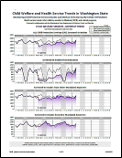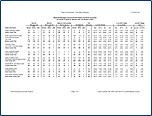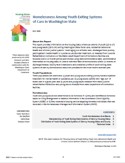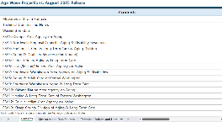RDA Dashboards are a series of periodical reports that present measures over time in the following areas:
Behavioral Health Treatment Needs and Outcomes among Medicaid Enrolled Children in Washington State
This dashboard provides a snapshot of behavioral health needs and outcomes for children and youth ages 0-20 enrolled in Medicaid in Washington State in SFY 2014-2021. Rates of behavioral health needs are compared across demographic categories, region, county, Medicaid coverage type, cross-system involvement, and abuse and neglect history. Outcomes examined include behavioral health treatment utilization, psychotropic polypharmacy, criminal legal involvement, emergency department utilization, injury rates, and teen pregnancy. Needs and outcomes are presented separately for the broad Medicaid population and the foster care subgroup, which has a substantially higher prevalence of behavioral health needs.
Child Welfare and Health Service Trends in Washington State: Monitoring Child Protective Services Intakes and Medical Visits During the COVID-19 Pandemic
 This dashboard displays current statewide monthly trends in child protective services (CPS) intakes and children’s medical visits from 2018 to present, with a focus on the impact of the COVID-19 pandemic. The primary CPS indicator is screened-in intakes, with separate charts by reporter type (educator, other mandated, non-mandated), domestic violence threat, and serious health concerns. Child health services indicators include injuries by type (assault, fracture, abuse-related), outpatient emergency department visits, and well-child visits. This work is produced in collaboration with the Washington State Department of Children, Youth, and Families (DCYF).
This dashboard displays current statewide monthly trends in child protective services (CPS) intakes and children’s medical visits from 2018 to present, with a focus on the impact of the COVID-19 pandemic. The primary CPS indicator is screened-in intakes, with separate charts by reporter type (educator, other mandated, non-mandated), domestic violence threat, and serious health concerns. Child health services indicators include injuries by type (assault, fracture, abuse-related), outpatient emergency department visits, and well-child visits. This work is produced in collaboration with the Washington State Department of Children, Youth, and Families (DCYF).
NOTE: This data was captured weekly prior to 2022. An archived version of the weekly data complete as of December 31, 2021 is available here.
Community Risk Profiles
 A comprehensive time-series collection of data related to substance use and abuse, and the risk factors that predict substance use among youth. Data are organized and presented within a risk and protective factor framework used across the state by substance abuse prevention planners. Data are available at the school district, locale, county and state level.
A comprehensive time-series collection of data related to substance use and abuse, and the risk factors that predict substance use among youth. Data are organized and presented within a risk and protective factor framework used across the state by substance abuse prevention planners. Data are available at the school district, locale, county and state level.
These reports contain the most recent data available. Up to twelve years of historical data may be presented for each indicator. Please be aware that the earlier published data may have been updated - or superseded - by the current reports. Additionally, some indicators may have been updated or otherwise changed from earlier published reports, so be sure to read data notes under a chart or a table. For the reports published in 1996-2001, follow this link to the archive.
Cross-System Outcome Measures for Adults Enrolled in Medicaid
As directed by Engrossed House Bill 1519 (Chapter 320, Laws of 2013)
With the passage of Engrossed House Bill 1519 (Chapter 320, Laws of 2013) and Second Substitute Senate Bill 5732 (Chapter 338, Laws of 2013), the Washington State Legislature directed that contracts the Department of Social and Health Services and the Health Care Authority execute with service contracting entities (Behavioral Health Organizations, Area Agencies on Aging, and Medicaid Managed Care Organizations) include measures to address shared client outcomes. Engrossed House Bill 1519 further directed the implementation of public reporting of outcome measures to allow for comparison of measures and levels of improvement across geographic regions of Washington State. This site provides results by Regional Service Area for selected client outcome measures for each delivery system.
Drug Court Participants: Recidivism and Key Outcome Measures
 These reports present recidivism measures and other key outcomes and characteristics of offenders participating in adult drug courts across Washington State. The reports contain yearly trends for individual courts and for courts statewide. Measures include drug court enrollment, demographics, recidivism, substance use disorder treatment participation, employment, and Medicaid enrollment. The reports were written in collaboration with the Criminal Justice Treatment Account Panel and the DSHS Behavioral Health Administration and will be updated annually.
These reports present recidivism measures and other key outcomes and characteristics of offenders participating in adult drug courts across Washington State. The reports contain yearly trends for individual courts and for courts statewide. Measures include drug court enrollment, demographics, recidivism, substance use disorder treatment participation, employment, and Medicaid enrollment. The reports were written in collaboration with the Criminal Justice Treatment Account Panel and the DSHS Behavioral Health Administration and will be updated annually.
ESA Service Trends Before and After COVID
 This dashboard describes changes in the number of participants in four public assistance programs before, during, and after the COVID-19 pandemic (January 2018 - March 2023): 1) Temporary Assistance for Needy Families (TANF), 2) Basic Food, 3) the Aged, Blind, and Disabled (ABD) cash assistance program, and 4) the Housing and Essential Needs (HEN) referral program. Program-specific caseload trends across subgroups, such as race/ethnicity, age, region, and homeless status are also examined. Additionally, this dashboard examines how the recent influx of immigrants from Ukraine, Russia, Afghanistan, Mexico, and other countries shaped caseload trends overall and by subgroups.
This dashboard describes changes in the number of participants in four public assistance programs before, during, and after the COVID-19 pandemic (January 2018 - March 2023): 1) Temporary Assistance for Needy Families (TANF), 2) Basic Food, 3) the Aged, Blind, and Disabled (ABD) cash assistance program, and 4) the Housing and Essential Needs (HEN) referral program. Program-specific caseload trends across subgroups, such as race/ethnicity, age, region, and homeless status are also examined. Additionally, this dashboard examines how the recent influx of immigrants from Ukraine, Russia, Afghanistan, Mexico, and other countries shaped caseload trends overall and by subgroups.
First Episode Psychosis Incidence among Individuals Enrolled in Medicaid
This interactive dashboard presents estimated incidence rates of first episode psychosis (FEP) among individuals enrolled in Medicaid in Washington State under the age of 65. Estimates include the total numbers and incidence rates of individuals experiencing a first episode of a psychotic disorder within the state fiscal year (SFY), disaggregated by geographic area, Medicaid enrollment status, and sociodemographic characteristics, including age, sex, race and ethnicity, and urbanicity category. Separate estimates are provided for the subset of individuals ages 15 – 40 who potentially qualify for New Journeys services, an evidence-based, early intervention program for individuals experiencing psychosis.
Click here to explore the interactive Dashboard.
First Steps and Reproductive Health
 Data on family planning, pregnancy care, births, and infant outcomes for Apple Health (Medicaid) and Washington.
Data on family planning, pregnancy care, births, and infant outcomes for Apple Health (Medicaid) and Washington.
Forecasts of Use of Long-Term Services and Supports, the Aging Population, and Dementia Prevalence through 2040 in Washington State
This report provides technical details about the methods used to produce a series of Area Agency on Aging (AAA) and county long-range forecasts of:
- Utilization of Medicaid-funded in-home, community residential, and skilled nursing facility services benchmarked to April 2024 utilization rates;
- Persons meeting demographic criteria related to age, income, language, race/ethnicity; and
- Prevalence of disability and dementia.
For these forecasts, we combined population projection data maintained by the Office of Financial Management (OFM) with other data sources containing county or state estimates of prevalence or service utilization. First, we describe the current methods and then discuss the differences from previous years’ methodology. For reference, a table containing Washington State level forecasts of the measures developed in this study is presented at the end of this technical report.
Homelessness Among Youth Exiting Systems of Care in Washington State
 Homelessness Among Youth Exiting Systems of Care in Washington State describes the housing status (homeless versus not) and characteristics of youth and young adults (ages 12 to 24) aging out of Washington State foster care, discharged from publicly funded residential or inpatient treatment for behavior health, released from Juvenile Rehabilitation institutions or released from an adult correctional facility. The report—a collaboration between the Department of Social and Health Services Research and Data Analysis Division and the Department of Commerce—describes youth characteristics and housing status over a one-year follow-up period and will be updated annually. This dashboard replaces the Housing Status of Youth Exiting Foster Care, Behavioral Health and Criminal Justice Systems report.
Homelessness Among Youth Exiting Systems of Care in Washington State describes the housing status (homeless versus not) and characteristics of youth and young adults (ages 12 to 24) aging out of Washington State foster care, discharged from publicly funded residential or inpatient treatment for behavior health, released from Juvenile Rehabilitation institutions or released from an adult correctional facility. The report—a collaboration between the Department of Social and Health Services Research and Data Analysis Division and the Department of Commerce—describes youth characteristics and housing status over a one-year follow-up period and will be updated annually. This dashboard replaces the Housing Status of Youth Exiting Foster Care, Behavioral Health and Criminal Justice Systems report.
Profiles of Persons Served by DSHS and Washington State Housing Authorities
 These report provides annual, aggregate snapshots and trends of characteristics, service utilization and well-being of households and individuals receiving housing assistance administered by local public housing authorities/agencies (PHA) in Washington State, within the calendar years. In addition to person and household counts and demographic trends, the report describes employment and earnings, health status, behavioral health treatment need, financial assistance, social services utilization, criminal justice involvement, and neighborhood characteristics. Separate reports are available statewide and for any housing authority submitting an Annual Plan to the Department of Housing and Urban Development (HUD). This project was funded by the Bill & Melinda Gates Foundation and HUD and benefited from the collaboration and advice of staff from the King County, Seattle, and Tacoma Housing Authorities. Contingent on the continued availability of HUD data, reports will be generated annually.
These report provides annual, aggregate snapshots and trends of characteristics, service utilization and well-being of households and individuals receiving housing assistance administered by local public housing authorities/agencies (PHA) in Washington State, within the calendar years. In addition to person and household counts and demographic trends, the report describes employment and earnings, health status, behavioral health treatment need, financial assistance, social services utilization, criminal justice involvement, and neighborhood characteristics. Separate reports are available statewide and for any housing authority submitting an Annual Plan to the Department of Housing and Urban Development (HUD). This project was funded by the Bill & Melinda Gates Foundation and HUD and benefited from the collaboration and advice of staff from the King County, Seattle, and Tacoma Housing Authorities. Contingent on the continued availability of HUD data, reports will be generated annually.



